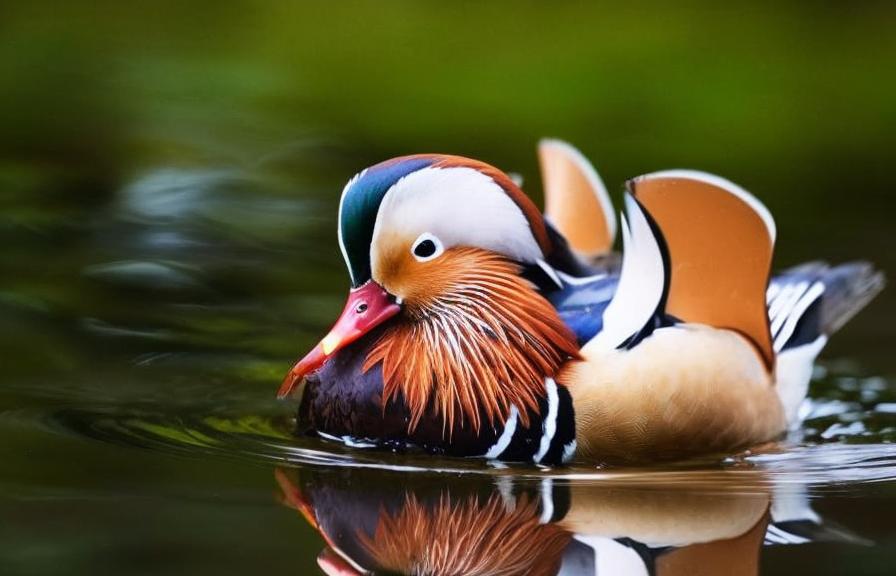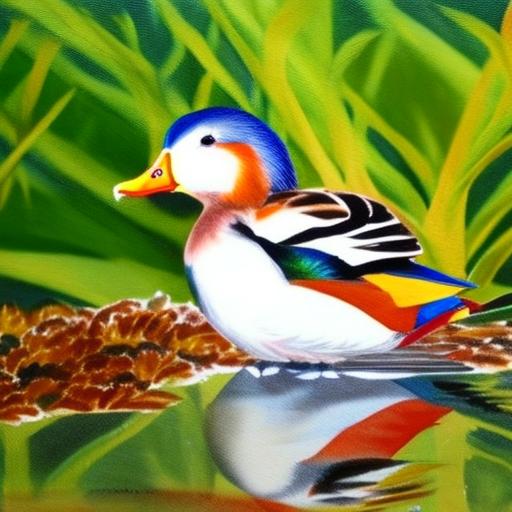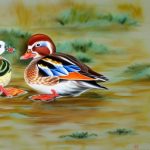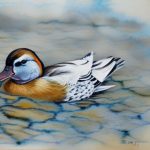Mandarin ducks, also known as Aix galericulata, are one of the most beautiful and colorful species of ducks in the world. They are native to East Asia, particularly in China, Japan, and Korea. These ducks are known for their stunning plumage, with the males sporting vibrant colors of purple, green, blue, and orange, while the females have more subtle shades of brown and grey. Mandarin ducks are monogamous birds, often forming strong pair bonds that can last for many years. They are also known for their graceful and elegant movements, making them a popular choice for ornamental ponds and aviaries.
Mandarin ducks are not only admired for their beauty but also for their symbolism in many Asian cultures. In China, they are considered a symbol of love and marital fidelity, often depicted in traditional art as a representation of a happy and harmonious marriage. In Japan, they are associated with prosperity and good fortune, often featured in wedding ceremonies and decorations. Due to their cultural significance and stunning appearance, Mandarin ducks have become a popular choice for aviculture enthusiasts and breeders around the world.
Key Takeaways
- Mandarin ducks are known for their vibrant and colorful plumage, making them a popular choice for breeders and enthusiasts.
- When selecting breeding pairs, it is important to consider the ducks’ health, temperament, and genetic diversity to ensure successful breeding and healthy offspring.
- Creating the ideal breeding environment involves providing a spacious and secure enclosure with access to water, natural vegetation, and nesting sites.
- Nesting and egg laying typically occur in the spring, and it is important to provide nesting materials and a quiet, secluded area for the ducks to lay and incubate their eggs.
- Incubation and hatching require careful monitoring of temperature and humidity levels, as well as providing a safe and clean environment for the ducklings to hatch and grow.
Selecting Breeding Pairs
When it comes to breeding Mandarin ducks, selecting the right breeding pairs is crucial for producing healthy and genetically diverse offspring. It is important to choose ducks that are in prime breeding condition, with vibrant plumage and good overall health. When selecting breeding pairs, it is essential to consider genetic diversity to avoid inbreeding and maintain the overall health of the population. Breeders should also consider the temperament and behavior of the ducks, as compatibility between the pair is essential for successful breeding and raising ducklings.
In addition to physical attributes, breeders should also consider the lineage and genetic history of the ducks when selecting breeding pairs. By keeping detailed records of the ducks’ ancestry, breeders can avoid pairing closely related individuals and maintain a healthy gene pool within their breeding population. It is also important to consider the ducks’ reproductive history, as experienced breeders are more likely to have successful breeding outcomes. By carefully selecting breeding pairs based on physical attributes, genetic diversity, and reproductive history, breeders can increase the likelihood of producing healthy and vibrant ducklings.
Creating the Ideal Breeding Environment
Creating the ideal breeding environment is essential for encouraging natural breeding behaviors and successful reproduction in Mandarin ducks. The breeding environment should mimic the natural habitat of Mandarin ducks, providing ample space for swimming, foraging, and nesting. A well-designed aviary or pond with clean water, natural vegetation, and hiding spots will help create a stress-free environment for the ducks to engage in courtship and mating behaviors. Providing a variety of nesting materials such as straw, grass, and feathers will also encourage the ducks to build nests and lay eggs.
In addition to the physical environment, it is important to consider the social dynamics within the breeding group. Mandarin ducks are known for their monogamous behavior, so it is essential to pair them off in compatible male-female pairs to encourage bonding and mating. By observing the ducks’ behavior and interactions, breeders can identify compatible pairs and ensure a harmonious breeding environment. It is also important to minimize disturbances and stressors in the breeding environment, as this can negatively impact the ducks’ reproductive behaviors and overall well-being. By creating a naturalistic and harmonious breeding environment, breeders can encourage natural breeding behaviors and increase the likelihood of successful reproduction.
Nesting and Egg Laying
Nesting and egg laying are critical stages in the breeding process of Mandarin ducks. Female ducks typically begin searching for suitable nesting sites in early spring, often choosing secluded areas near water with ample vegetation for cover. Providing nesting boxes or platforms within the aviary or pond can encourage the ducks to build nests in a safe and protected environment. Female ducks will gather nesting materials such as grass, leaves, and feathers to construct their nests, preparing them for egg laying.
Once the nest is built, female ducks will lay a clutch of eggs over several days, typically laying one egg per day until the clutch is complete. Mandarin duck eggs are creamy white in color and slightly larger than chicken eggs. It is essential to provide a quiet and undisturbed environment during this time to minimize stress on the nesting female. Breeders should also monitor the nest regularly to ensure that the eggs are being properly incubated and protected from predators. By providing a suitable nesting site and minimizing disturbances, breeders can support the natural nesting and egg-laying behaviors of Mandarin ducks.
Incubation and Hatching
After the female duck has completed laying her clutch of eggs, she will begin incubating them to stimulate embryonic development. The incubation period for Mandarin duck eggs is approximately 28-30 days, during which time the female will diligently tend to the eggs, keeping them warm and protected. It is important to provide a quiet and stress-free environment during this time to ensure successful incubation. Breeders should also monitor the nest regularly to ensure that the eggs are developing properly and are not at risk of predation or disturbance.
As the incubation period nears its end, breeders should prepare for the hatching process by providing a safe and warm environment for the ducklings to emerge. Once the eggs begin to hatch, it is crucial to provide ample space for the ducklings to move around freely and access water for swimming. Breeders should also monitor the hatching process closely to ensure that all ducklings have successfully emerged from their eggs and are healthy. By providing a suitable environment for incubation and hatching, breeders can support the natural reproductive behaviors of Mandarin ducks and increase the likelihood of successful hatching.
Caring for Ducklings

Caring for ducklings requires careful attention to their nutritional needs, social development, and overall well-being. Shortly after hatching, ducklings will require access to water for swimming and foraging, as well as a balanced diet of commercial waterfowl starter feed supplemented with fresh greens and insects. It is essential to provide a warm and secure brooding area for the ducklings to protect them from predators and maintain their body temperature. Breeders should also monitor the social dynamics within the duckling group to ensure that they are interacting positively and developing social skills.
As ducklings grow, they will begin to explore their environment more independently, requiring ample space for exercise and natural behaviors such as foraging and swimming. Providing a well-designed pond or aviary with natural vegetation and hiding spots will encourage natural behaviors in ducklings and support their physical development. It is also important to monitor the health of ducklings regularly, providing veterinary care as needed to address any health concerns or issues. By providing a nurturing environment with proper nutrition, social interaction, and veterinary care, breeders can support the healthy development of Mandarin ducklings.
Monitoring the Health and Well-being of Mandarin Ducks
Monitoring the health and well-being of Mandarin ducks is essential for maintaining a thriving breeding population. Regular health checks should be conducted to monitor the ducks’ overall condition, including their plumage quality, body weight, and behavior. Any signs of illness or injury should be addressed promptly with appropriate veterinary care to prevent the spread of disease or further complications. It is also important to provide a balanced diet with access to clean water and appropriate nutritional supplements to support the ducks’ overall health.
In addition to physical health, it is important to monitor the social dynamics within the breeding group to ensure that compatible pairs are forming strong bonds and engaging in natural mating behaviors. Observing courtship displays, mating behaviors, and nesting activities can provide valuable insights into the reproductive health of Mandarin ducks. By maintaining detailed records of breeding outcomes and reproductive behaviors, breeders can identify any potential issues or challenges that may arise within their breeding population. By monitoring the health and well-being of Mandarin ducks closely, breeders can ensure a thriving and genetically diverse population for future generations.
In conclusion, breeding Mandarin ducks requires careful consideration of genetic diversity, environmental enrichment, reproductive behaviors, incubation care, duckling development, and overall health monitoring. By providing a naturalistic breeding environment with suitable nesting sites, minimizing disturbances during egg laying and incubation periods, supporting healthy duckling development, and monitoring the overall health of Mandarin ducks closely, breeders can contribute to the conservation of this stunning species while enjoying their beauty in aviculture settings around the world.
If you’re interested in breeding mandarin ducks, you might also want to consider creating a suitable environment for them. A large chicken coop can provide the space and protection needed for these beautiful birds to thrive. Check out this article on large chicken coop ideas for inspiration on how to create a comfortable and secure space for your mandarin ducks.
FAQs
What is the breeding season for mandarin ducks?
The breeding season for mandarin ducks typically occurs from late April to early June.
How do mandarin ducks choose their mates?
Mandarin ducks are monogamous and typically choose their mates during the breeding season through courtship displays and vocalizations.
Where do mandarin ducks build their nests?
Mandarin ducks build their nests in tree cavities, typically near water sources such as ponds, lakes, or rivers.
What do mandarin ducks eat during the breeding season?
During the breeding season, mandarin ducks primarily feed on a diet of seeds, grains, aquatic plants, and small insects.
How many eggs do mandarin ducks typically lay?
Mandarin ducks typically lay a clutch of 9-12 eggs, with an incubation period of around 28-30 days.
Do mandarin ducks raise their young together?
After hatching, the female mandarin duck cares for the ducklings while the male may leave to molt. The female will lead the ducklings to water within a day of hatching.
Are mandarin ducks protected species?
Yes, mandarin ducks are protected in many countries due to their striking plumage and declining populations in the wild.
Meet Walter, the feathered-friend fanatic of Florida! Nestled in the sunshine state, Walter struts through life with his feathered companions, clucking his way to happiness. With a coop that’s fancier than a five-star hotel, he’s the Don Juan of the chicken world. When he’s not teaching his hens to do the cha-cha, you’ll find him in a heated debate with his prized rooster, Sir Clucks-a-Lot. Walter’s poultry passion is no yolk; he’s the sunny-side-up guy you never knew you needed in your flock of friends!







